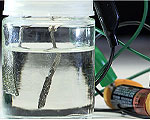Nanoscale Material Brings Emissions-Free Fuel Cells Closer
 Sep-02-14
Researchers have developed a nanoscale material that that could help bring emissions-free fuel cell-powered vehicles a bit closer to the market.
Sep-02-14
Researchers have developed a nanoscale material that that could help bring emissions-free fuel cell-powered vehicles a bit closer to the market.Although fuel cell vehicles will soon be available to consumers, most of those vehicles will still be powered by hydrogen made using natural gas. In search of a fossil fuel-free alternative, the team from Stanford University created a low-cost catalyst that makes it possible to split water at room temperature using only the current from a 1.5-volt battery. The catalyst is made of nickel and iron--in contrast to previous catalysts made of expensive platinum and iridium--and marks the first time anyone has made a catalyst able to function at such a low voltage from non-precious metals.
The Stanford team is now looking at ways to improve the material's durability and make it more feasible for industrial applications.
More Info about this Invention:
[IEEE.ORG][NEWS.STANFORD.EDU]

Add Your Comment